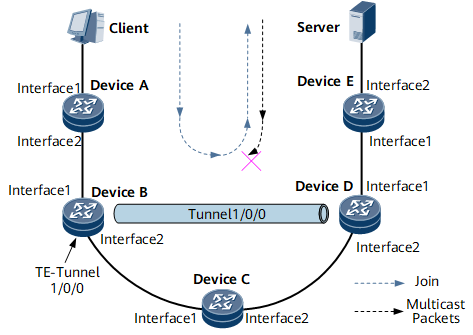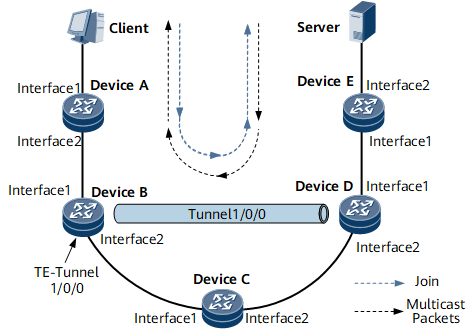IS-IS Local MT
Background
When multicast and an IGP Shortcut-enabled MPLS TE tunnel are configured on a network, the outbound interface of the route calculated by IS-IS may not be a physical interface but a TE tunnel interface. Multicast Join packets are transparent to routers through which the TE tunnel passes. Therefore, these routers cannot generate multicast forwarding entries and discard received multicast packets from the multicast source. Figure 1 shows the conflict between multicast and a TE tunnel.
Client and Server exchange multicast packets as follows:
Client sends a Report message to Device A, requesting to join the multicast group. Upon receipt, Device A sends a Join packet to Device B.
After Device B receives the Join packet, it selects TE-Tunnel 1/0/0 as the reverse path forwarding (RPF) interface and adds an MPLS label to the packet before forwarding it from Interface2 to Device C.
As the penultimate hop of the TE tunnel, Device C removes the MPLS label from the Join packet before forwarding it from Interface2 to Device D. Because the forwarding is based on MPLS, Device C does not generate any multicast forwarding entries.
After Device D receives the Join packet, it generates a multicast forwarding entry in which the upstream and downstream interfaces are Interface1 and Interface2, respectively. Device D then sends the Join packet to Device E, which has already established the shortest path tree.
Multicast packets flow from Server to Device C through Device E and Device D. Device C discards these packets because no multicast forwarding entry is available. As a result, multicast services are interrupted.
IS-IS local multicast topology (MT) can address this problem.
Related Concepts
IS-IS local MT is a mechanism that enables the routing management (RM) module to create a separate multicast topology on the local device so that protocol packets exchanged between devices are not erroneously discarded. When the outbound interface of the route calculated by IS-IS is an IGP Shortcut-enabled TE tunnel interface, IS-IS local MT calculates a physical outbound interface for the route. This mechanism resolves the conflict between multicast and a TE tunnel.

The TE tunnel described in this section is IGP Shortcut-enabled.
Implementation
Establishment of a multicast IGP (MIGP) routing table
Device B creates an independent MIGP routing table, records the TE tunnel interface, and generates multicast routing entries for multicast packet forwarding. If the outbound interface of a calculated route is a TE tunnel interface, IS-IS calculates a physical outbound interface for the route and adds the route to the MIGP routing table.
Multicast packet forwarding
When forwarding multicast packets, a router searches the unicast routing table for a route. If the next hop of the route is a tunnel interface, the router searches the MIGP routing table for the physical outbound interface to forward multicast packets. In this example, the original outbound interface of the route is TE tunnel 1/0/0. IS-IS re-calculates a physical outbound interface (Interface2) for the route and adds the route to the MIGP routing table. Device B then forwards multicast packets through Interface2 based on the MIGP routing table and generates a multicast routing entry in the multicast routing table. Therefore, multicast services are properly forwarded.
Usage Scenario
IS-IS local MT prevents multicast services from being interrupted on networks, which allows multicasting and has an IGP Shortcut-enabled TE tunnel.
Benefits
Local MT resolves the conflict between multicast and a TE tunnel and improves multicast service reliability.

